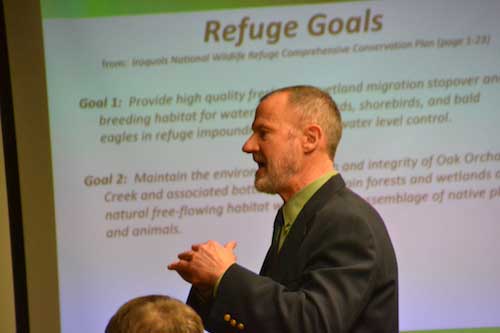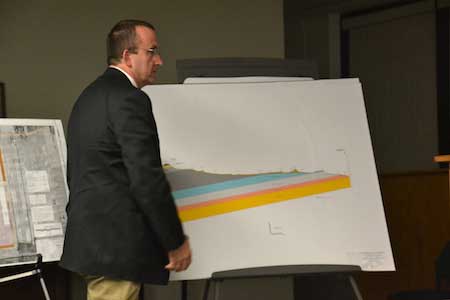Frontier believes it has resolved concerns with quarry by refuge
‘We went from this being no harm to being a great asset to the refuge over time.’ – Kevin Brown, attorney for Frontier

Sam Gowan, president Alpha Geoscience, discusses the hydrogeology at the proposed quarry site and the impact of dewatering on the refuge and neighbors’ wells.
SHELBY – Frontier Stone had a team of scientists and attorneys at the Shelby Town Board meeting on Monday, presenting how the company has worked for years on a plan to address environmental impacts of the project that touches the northern boundary of the Iroquois National Wildlife Refuge.
Frontier’s studies and plans show the project will not have a negative impact on groundwater, wildlife at the refuge, or companies in nanotechnology at the STAMP site on the other side of the refuge in Alabama.
The proposed quarry would be built in four phases over 75 years, with the first phase to be 11.6 acres in the first 8 to 10 years.
When phase one is complete, that area will be turned into a reservoir, with water to be released to help the refuge during drought or other low water periods, said Kevin Brown, an attorney for Frontier.
The company hydrogeologist has a plan that turns the quarry into an asset for the refuge by supplementing water to the site, Brown said.
“We went from this being no harm (to the refuge) to this being a great asset to the refuge over time,” Brown told the Shelby Town Board during a presentation on Monday. “This could actually be what the refuge needs with climate change.”
He noted the drought last summer, and the potential for more weather extremes with climate change. The quarry, by helping the refuge with water in the future, could make the 11,000-acre site more resilient, Brown told the Shelby Town Board.
Frontier plans to pump 554,000 gallons of water daily to quarry the stone.
Sam Gowan, president Alpha Geoscience, has worked with Frontier since 2008 on the project in Shelby. Gowan said the site is planned to eventually have two reservoirs and can alternate discharges to the refuge, providing needed water.
“2016 was a real eye-opener for where we’re heading with drought conditions,” he said.
The quarry could discharge into the refuge, “which would be a great asset” during droughts or low water flows, he said.

Jason Kappel, senior geologist for Continental Placer, said a swath of the Lockport formation runs through Shelby, but the proposed quarry site is thick, 115 to 120 feet of the stone, and it’s close to the surface.
Frontier’s team went through its plan for mitigating noise, dust, and other impacts on the neighborhood and refuge.
The company will have seismographs to measure ground vibrations from blasting near the quarry and the STAMP site.
The DEC reviewed the company’s plans and found there were no issues to be resolved with blasting, noise, dust, STAMP, Job Corps, dewatering and surface water discharges, or wildlife, including short-eared owls and northern harriers.
The DEC hasn’t issued a final permit yet for the project. Frontier also needs to get a permit from the town, but first needs to get the final OK from the state DEC.
The company also needs the zoning to be changed for the area along Fletcher Chapel Road to allow an industrial use in a residential-agricultural area.
Town officials asked Frontier what happens to the site after its projected 75 years of quarrying. The company’s plans show two lakes or reservoirs that would be 35.2 acres and 156.1 acres. Who would pau to pump water from the reservoirs to the refuge at that point, Town Supervisor Skip Draper asked.
Brown, the Frontier attorney, said that hasn’t been determined.
“This is something we haven’t fully resolved,” Brown told the town officials. “We can resolve it.”
Draper said he doesn’t want it to fall on the town or the refuge to be the caretaker of the quarry when the stone is exhausted from the site.
“We really need a mechanism for pumping water from the site after 75 years,” Dan Spitzer, an attorney for Shelby, told Frontier.
Brown said the project has been in development for about 15 years with Frontier stepping up to resolve concerns raised by the DEC and community.
The company is planning 30-foot high berms to shield some of the dust and noise. Frontier also will pay to have Fletcher Chapel Road upgraded to accommodate the truck traffic from the site.

Town Supervisor Skip Draper, right, and Dan Spitzer, an attorney for the town, listen to a presentation on Monday from Frontier about its proposed quarry in Shelby.
The company expects 30 truck trips per hour, with 15 coming and going during the 6 a.m. to 6 p.m. operational hours from Monday through Friday and 6 a.m. to noon on Saturday. Most of the truck traffic would come from Route 63 and Oak Orchard Ridge Road.
Frontier was asked why it wants to have a quarry by the refuge. Jason Kappel, senior geologist for Continental Placer, said a swath of the Lockport dolomite formation runs through Shelby, but the proposed quarry site on land owned by Chester Zelazny is thick with 115 to 120 feet of the stone. It’s also close to the surface. Other spots in the town don’t have such a thick swath of the stone, and it’s often farther down below ground, Kappel said, calling the stone on Zelazny’s land “a sweet spot.”
Frontier plans to quarry 350,000 tons of a stone a year from the site, but that number will depend on the market demand, Kappel said.
Brown, the Frontier attorney, said the quarry will fill a need in Western New York, providing high-quality aggregate.
Spitzer, the town attorney, asked Brown if the company would prepare an overall climate change impact study, because Brown emphasized the project would be an asset to the refuge. Spitzer wondered if the overall impact on the environment, including truck hauling, was considered in terms of climate change.
Brown said such a study isn’t required by the DEC. He would see if Frontier’s owner, David Mahar, is interested in spending the money for such a study.






































































